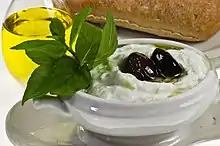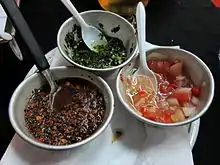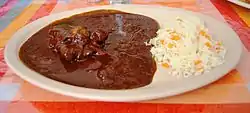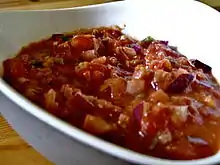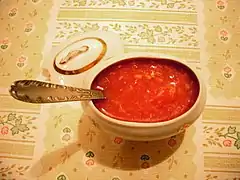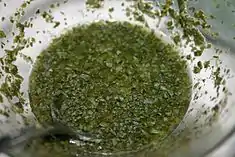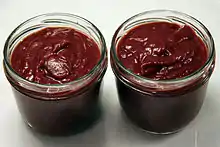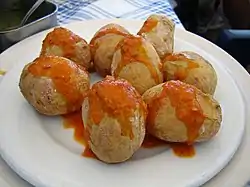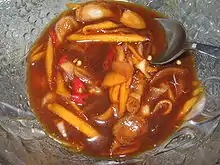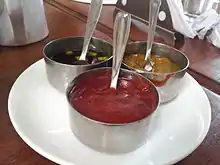List of sauces
The following is a list of notable culinary and prepared sauces used in cooking and food service.
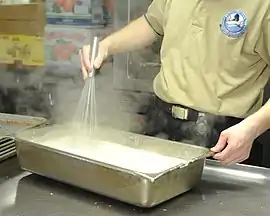
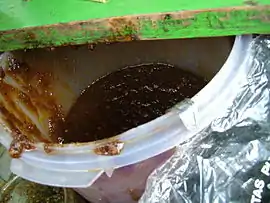
General
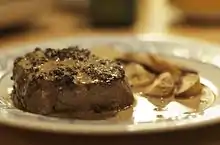
- Anchovy essence – Thick, oily sauce of pounded anchovies and spices
- Avgolemono – Egg-lemon sauce or soup
- Avocado sauce – Sauce prepared using avocado as a primary ingredient
- Barbecue sauce – Sauce used as a marinade, basting, topping or condiment[1]
- Bread sauce
- Cheese sauce – Sauce made with cheese
- Cocktail sauce – Condiment
- Coffee sauce
- Corn sauce
- Coulis – Thin sauce made from puréed and strained vegetables or fruits
- Duck sauce – American Chinese condiment with a translucent orange appearance
- Egusi sauce
- Fry sauce – Sauce used as a condiment often served with fries
- Mahyawa
- Mignonette sauce
- Mint sauce – Sauce made of chopped mint
- Mushroom ketchup – Style of ketchup
- Normande sauce
- Pan sauce
- Peppercorn sauce
- Rainbow sauce – Type of culinary sauce
- Ravigote sauce
- Romesco
- Salad dressing – Food mixture, served chilled or at room temperature
- Salsa (salsa roja)
- Satsebeli
- Sauce andalouse
- Sauce aurore – a velouté sauce flavored with tomato[2]
- Sauce bercy
- Sauce poulette – prepared using mushrooms and lemon[3]
- Sauce vin blanc
- Sofrito – Cooked vegetable foundation for cooking
- Sour cream sauce
- Steak sauce
- Sweet chili sauce – Condiment primarily used as a dip
- Tomato sauce – Sauce made primarily from tomatoes
- Vinaigrette – Sauce made from oil and vinegar and commonly used as a salad dressing
- Wine sauce
- Worcestershire sauce – Fermented condiment
By type
Brown sauces
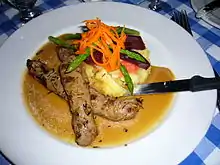
Brown sauces include:
- Bordelaise sauce
- Chateaubriand sauce
- Charcutiere sauce
- Chaudfroid sauce[4]
- Demi glace – Sauce in French cuisine
- Gravy – Sauce made from the juices of meats
- Mushroom gravy
- Romesco sauce
- Sauce Africaine
- Sauce au Poivre
- Sauce Robert[5]
Butter sauces
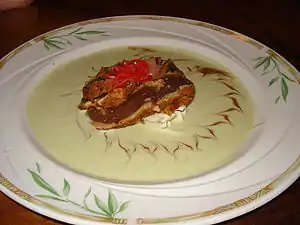
- Beurre blanc
- Beurre manie
- Beurre monté
- Beurre noisette
- Café de Paris – Butter-based sauce
- Meuniere sauce
Emulsified sauces
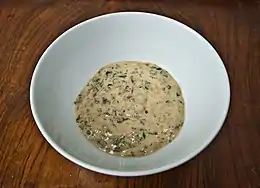
- Aioli – West Mediterranean sauce of garlic and oil
- Béarnaise sauce – Sauce made of clarified butter and egg yolk
- Garlic sauce – Sauce with garlic as a main ingredient
- Hollandaise sauce – Sauce made of egg, butter, and lemon[6]
- Mayonnaise – Thick cold sauce
- Remoulade – Mayonnaise-based cold sauce[7]
- Salad cream – Dressing similar to mayonnaise
- Tartare sauce(w/ chilli)[8]
Fish sauces
- Bagna càuda – Italian hot dish made from garlic and anchovies
- Clam sauce – Pasta sauce
- Garum – Classical period fermented fish sauce
Green sauces
- See Green sauce – Sauce made from chopped herbs
Tomato sauces
- Tomato sauces
- Ketchup – Sauce used as a condiment
Hot sauces
- Pepper sauces
- Mustard sauces
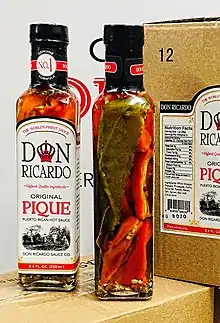 Pique sauce
Pique sauce- Mustard – Condiment made from mustard seeds
- Chile pepper-tinged sauces
.jpg.webp)
- Hot sauce – Chili pepper-based condiments include:
- Buffalo Sauce
- Chili sauce
- Datil pepper sauce
- Enchilada – Corn tortilla rolled around a filling and covered with a sauce sauce
- Pique Sauce
- Sriracha sauce
- Tabasco sauce – American hot sauce brand
Meat-based sauces
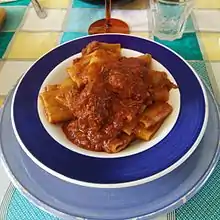
- Amatriciana sauce – Traditional Italian pasta sauce
- Barese ragù
- Bolognese – Italian pasta sauce of tomatoes and meat
- Carbonara – Italian pasta dish
- Cincinnati chili – Spiced meat sauce used as a topping for spaghetti
- Neapolitan ragù – Italian meat sauce
- Picadillo – Ground meat and tomato dish popular in Latin America and the Philippines
- Ragù – Meat-based sauce in Italian cuisine
Pink sauces
- See Pink sauce
Sauces made of chopped fresh ingredients
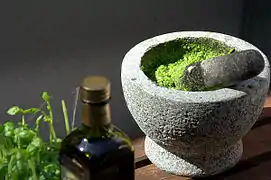
- Chimichurri – Food sauce
- Gremolata – Condiment for ossobuco
- Mujdei – Spicy Romanian sauce made mostly from garlic and vegetable oil
- Onion sauce
- Persillade
- Pesto – Sauce made from basil, pine nuts, parmesan, garlic, and olive oil
- Pico de gallo – Mexican condiment
- Latin American Salsa cruda of various kinds
- Salsa verde – Spicy Mexican sauce based on tomatillos
- Sauce gribiche – Cold egg sauce
- Sauce vierge
- Tkemali
Sweet sauces

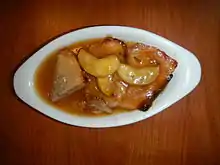
- Apple sauce – Sauce or puree made from apples
- Blueberry sauce – Compote or savory sauce made with blueberries
- Butterscotch sauce – Type of confectionery
- Caramel – Confectionery product made by heating sugars
- Chocolate gravy
- Chocolate syrup – Chocolate-flavored condiment used as a topping or ingredient
- Cranberry sauce – Sauce or relish made from cranberries
- Crème anglaise
- Custard – Semi-solid cooked mixture of milk and egg
- Fudge sauce – Chocolate-flavored condiment used as a topping or ingredient
- Hard sauce – not liquid, but called a sauce nonetheless
- Sweet chili sauce – Condiment primarily used as a dip
- Mango sauce
- Peach sauce
- Plum sauce
- Strawberry sauce
- Syrup – Thick, viscous solution of sugar in water
- Tkemali
- Zabaione – Italian dessert made with egg, sugar, and wine
White sauces
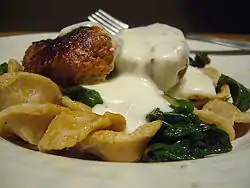
- Alfredo sauce
- Béchamel sauce – Sauce of the Italian and French cuisines[9]
- Caruso sauce – Cream sauce for pasta
- Mushroom sauce
- Mornay sauce – Type of béchamel sauce including cheese
- Sauce Allemande – Sauce used in classic French cuisine
- Sauce Américaine
- Suprême sauce
- Velouté sauce – Classic French sauce
- Yogurt sauce – Food produced by bacterial fermentation of milk
By region
Africa
Sauces in African cuisine include:
East Asian sauces
- Prepared sauces
- Doubanjiang – Chinese spicy bean paste ingredient
- Hoisin sauce – Sauce commonly used in Chinese cuisine
- Mala sauce
- Mirin – Type of rice wine used in Japanese cuisine
- Oyster sauce – Condiment
- Plum sauce (Chinese; see umeboshi paste below for Japanese pickled plum sauce)
- Ponzu – Japanese citrus-based condiment
- Soy sauce – East Asian liquid condiment of Chinese origin
- Sweet soy sauce – Sweetened aromatic soy sauce, originating from Indonesia
- Sriracha sauce
- Ssamjang – Spicy paste used in Korean cuisine
- Tentsuyu
- Umeboshi paste, or Japanese pickled plum sauce, a thick sauce from a fruit called a plum in English but which is closer to an apricot
- XO sauce
- Cooked sauces
- Lobster sauce
- Shacha sauce
- Siu haau sauce
- Sweet and sour sauce
- Sweet bean sauce, also known as Tianmianjiang
- Teriyaki – Japanese marinade – a way of cooking in Japan, a branch of sauces in North America
Southeast Asian sauces
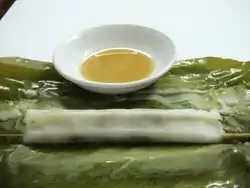
- Budu – Fish sauce originating from east coast of Peninsular Malaysia
- Fish sauce – Condiment made from fish
- Nam chim
- Nam phrik – Thai chili sauce
- Nước chấm – Vietnamese dipping sauce
- Padaek – Traditional Lao condiment made from pickled or fermented fish that has been cured
- Pecel – Indonesian vegetable dish
- Pla ra – Southeast Asian fermented fish seasoning
- Sambal – Spicy relish or sauce
- Peanut sauce, also known as Satay sauce – Indonesian sauce made from ground roasted or fried peanuts
- Saus cabai
- Sriracha sauce
- Sweet soy sauce – Sweetened aromatic soy sauce, originating from Indonesia
- Tương
Caucasus
Sauces in Caucasian cuisine (the Caucasus region) include:
Middle East
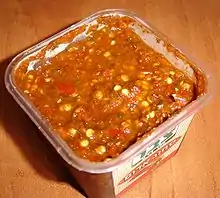
Sauces in Middle Eastern cuisine include:
South America
Sauces in South American cuisine include:
- Ají (sauce) – Ají-based condiment traditional in Andean cuisine
- Caruso sauce – Cream sauce for pasta
- Chancaca – Sweet sauce traditional to southern Andean cuisine
- Chimichurri – Food sauce
- Hogao – Colombian style sofrito
- Tucupi – Sauce used in Brazilian cuisine, extracted from the Cassava root
By country
Argentina
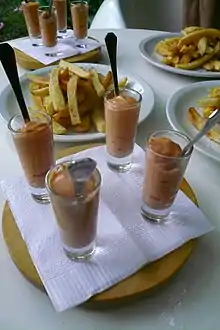
Sauces in Argentine cuisine include:
- Caruso sauce – Cream sauce for pasta
- Chimichurri – Food sauce
- Salsa golf – Cold sauce of mayonnaise and tomatoes[10]
- Salsa criolla – Type of salad or relish found in Latin American cuisine
- Picantina
- Tuco
Belgium
Sauces in Belgian cuisine include:
- Andalouse sauce - a mildly spiced sauce made from mayonnaise, tomatoes and peppers.
- "Bicky" sauce – a commercial brand made from mayonnaise, white cabbage, tarragon, cucumber, onion, mustard and dextrose
- Brasil sauce – mayonnaise with pureed pineapple, tomato and spices[12]
- Sauce "Pickles"– a yellow vinegar based sauce with turmeric, mustard and crunchy vegetable chunks, similar to Piccalilli.
- Zigeuner sauce – A "gypsy" sauce of tomatoes, paprika and chopped bell peppers, borrowed from Germany
- Sauce Lapin - a popular sauce made with Sirop de Liège
Brazil
Canada
Sauces in Canadian cuisine include:
- Donair sauce – Canadian restaurant chain
- Honey garlic sauce
Chile
- Pebre – Chilean condiment
- Salsa Americana – Chilean relish made of Pickles, Picked Onions and Pickled Carrots
- Chancho en piedra
China
Colombia
- Hogao – Colombian style sofrito
France
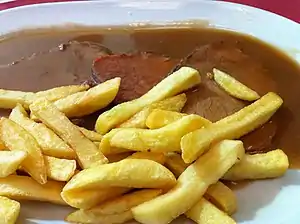
In the late 19th century, and early 20th century, the chef Auguste Escoffier consolidated the list of sauces proposed by Marie-Antoine Carême to four Grandes-Sauces-de-Base in Le guide culinaire.[13] They are:
- Sauce Espagnole – One of the basic sauces of classic French cuisine – a fortified brown veal stock sauce.
- Sauce Velouté – Classic French sauce – white stock-based sauce, thickened with a roux or a liaison.
- Sauce Béchamel – Sauce of the Italian and French cuisines – milk-based sauce, thickened with a white roux.
- Sauce Tomate – Sauce made primarily from tomatoes – a tomato-based sauce.
In addition to the four types of great base sauces that required heat to produce, he also wrote that sauce mayonnaise, as a cold sauce, was also a Sauce-Mère (Mother Sauce), in much the same way as Sauce Espagnole and Sauce Velouté due to the number of derivative sauces that can be produced.[14]
- Sauce Mayonnaise – Thick cold sauce – an emulsion of egg yolk, butter, and an acid such as lemon or vinegar.
In Escoffier's 1907 book A Guide to Modern Cookery, an abridged English version of his Le guide culinaire , it presented readers with a list of sauces[15] that have also come to be known as the Five Mother Sauces[16] of French cuisine:
Of his French language publications, both Le guide culinaire and his last book, Ma cuisine that was published in 1934, make no direct mention of Hollandaise as being a Sauce-Mère. Both titles do mention that Sauce Mayonnaise could be considered as a Sauce-Mère within their lists of cold sauces.[14] The 1979 English translation by Cracknell and Kaufmann of the 4th edition of Le guide culinaire also maintains similar wording.[17]
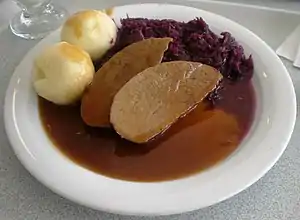
Additional sauces of French origin include:
| Sauce | Main ingredients | Ref |
|---|---|---|
| Beurres composés – compound butters | ||
| Beurre blanc | Reduction of butter, vinegar, white wine and shallots. | [18] |
| Beurre maître d'hôtel | Fresh butter kneaded with chopped parsley, pepper and lemon juice. | [19] |
| Beurre noir | Browned butter with lemon juice/vinegar and parsley; traditionally served with raie (skate). | [20] |
| Beurre noisette | Lightly browned butter with lemon juice. | [21] |
| Beurre vert | Butter mixed with the juice extracted from spinach. | [22] |
| Sauces | ||
| Allemande | Veal stock, veal velouté, lemon juice, mushrooms and egg yolks. | [23] |
| Américaine | Mayonnaise, blended with puréed lobster and mustard. | [24] |
| Béarnaise | Reduction of chopped shallots, pepper, tarragon and vinegar, with egg yolks and melted butter. | [25] |
| Bercy | Chopped shallots, butter and white wine, with either fish stock or meat stock. | [25] |
| Bordelaise | Chopped shallots, pepper, herbs, cooked in red wine and mixed with demi-glace. | [26] |
| Bourguignonne | Chopped shallots, herbs and mushroom trimmings reduced in red wine and meat stock. | [27] |
| Bretonne | Two forms: (i) chopped onions, butter, white wine tomatoes, garlic and parsley; (ii) julienne of leeks, celery, mushrooms and onions cooked slowly in butter and mixed with fish velouté. | [28] |
| Charcutière | Sauce Robert (below) garnished with gherkins. | [28] |
| Chasseur | Minced mushrooms, butter, shallots and parsley with red wine and demi-glace. | [28] |
| Demi-glace | A brown sauce, generally the basis of other sauces, made of beef or veal stock, with carrots, onions, mushrooms and tomatoes. | [29] |
| Gribiche | Mayonnaise with hard-boiled eggs, mustard, capers and herbs | [30] |
| Hollandaise | Vinegar, crushed peppercorns, butter, egg yolks and lemon juice. | [31] |
| Lyonnaise | Fried onions with white wine and vinegar reduced and mixed with demi-glace. | [32] |
| Mayonnaise | Egg yolks with vinegar or lemon juice, beaten with oil. | [32] |
| Nantua | Diced vegetables, butter, fish stock, white wine, cognac and tomatoes. | [33] |
| Périgueux | Demi-glace, chopped truffles and madeira. | [34] |
| Poivrade | Diced vegetables with herbs, with demi-glace | [35] |
| Ravigote | Reduction of white wine and vinegar with velouté and shallot butter, garnished with herbs. | [36] |
| Rémoulade | Mayonnaise seasoned with mustard and anchovy essence, garnished with chopped capers, gherkins, tarragon and chervil. | [37] |
| Robert | Chopped onions in butter, with white wine, vinegar, pepper, cooked in demi-glace and finished with mustard. | [36] |
| Rouennaise | Thin bordelaise mixed with puréed raw duck livers, gently cooked, finished with a reduction of red wine and shallots | [38] |
| Rouille | Garlic, pimento and chilli pepper sauce, traditionally served with fish soup. | [39] |
| Soubise | Onion sauce. Versions include (i) béchamel and cooked chopped onions and (ii) onions and rice in white stock, reduced to paste and blended with butter and cream. | [38] |
| Tartare | Cold sauce of mayonnaise with hard-boiled egg yolks, with onions and chives. | [38] |
| Vénitienne | White wine with a reduction of tarragon vinegar, shallots and chervil, finished with butter. | [38] |
Germany
Sauces in German cuisine include:
- Duckefett
- Frankfurt green sauce – Sauce made from chopped herbs
Greece
Sauces in Greek cuisine include:
- Skordalia – Thick purée in Greek cuisine using crushed garlic with a bulky base and olive oil
- Tzatziki – Cold cucumber-yogurt dip, soup, or sauce
- Avgolemono – Egg-lemon sauce or soup
- Melitzanosalata
- Taramasalata – Roe-based meze common to Turkey and Greece
India
Sauces are usually called Chatni or Chutney in India which are a part of almost every meal. Specifically, it is used as dip with most of the snacks.
- Coconut chutney (South India)
- Garlic chutney (South India)
- Dal/ groundnut chutney (South India)
- Pumpkin Chutney (South India)
- Bell pepper Chutney (South India)
- Methi Chutney (South India)
- Mango Chutney (South India)
- Coriander (North India)
- Mint chutney (North India)
- Tomato chutney
- Imli (North India)
- Green chillies
- Aloobukhara (North India)
- Khajoor (North India)
Indonesia
Sauces in Indonesian cuisine include:
- Dabu-dabu – Indonesian hot and spicy condiment
- Colo-colo – Indonesian hot and spicy condiment
- Peanut sauce – Indonesian sauce made from ground roasted or fried peanuts
- Pecel – Indonesian vegetable dish
- Sambal – Spicy relish or sauce
- Sweet soy sauce – Sweetened aromatic soy sauce, originating from Indonesia
Italy
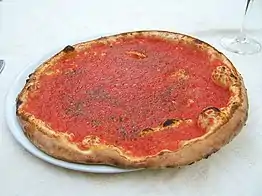
Sauces in Italian cuisine include:
- Agliata – Savory and pungent garlic sauce and condiment in Italian cuisine – a garlic sauce in Italian cuisine
- Agrodolce
- Alfredo – Italian pasta dish with butter and cheese
- Arrabbiata sauce – Spicy tomato sauce for pasta
- Bagna càuda – Italian hot dish made from garlic and anchovies
- Bolognese sauce – Italian pasta sauce of tomatoes and meat
- Checca sauce
- Fra diavolo sauce – Spicy Italian sauce for pasta, seafood or chicken
- Genovese sauce – Meat sauce
- Marinara sauce[40]
- Neapolitan sauce – Tomato-based sauce derived from Italian cuisine
- Parma Rosa - A blend of marinara and alfredo.
- Pearà
- Pesto – Sauce made from basil, pine nuts, parmesan, garlic, and olive oil
- Ragù – Meat-based sauce in Italian cuisine[41]
- Neapolitan ragù – Italian meat sauce
- Ragù alla salsiccia – Tomato-based sauce with sausage
- Savore Sanguino
- Sugo all'amatriciana
- Sugo alla puttanesca – Neapolitan pasta dish
- Vincotto – Italian dessert paste
Japan
Sauces in Japanese cuisine include:
- Shottsuru
- Tare sauce – Family of Japanese sauces
- Ponzu – Japanese citrus-based condiment
- Umeboshi paste, or Japanese pickled plum sauce
- Tonkatsu sauce – Japanese seasoning sauce
Korea

Sauces in Korean cuisine include:
- Korean soy sauce – East Asian liquid condiment of Chinese origin[42]
Mexico
Sauces in Mexican cuisine include:
- Guacamole – Mexican avocado-based dip, spread, or salad[44]
- Mole[45]
- Pico de gallo – Mexican condiment
- Salsa Macha
- Salsa Verde
- Salsa Roja
- Salsa Borracha
Philippines
Sauces in Philippine cuisine include:
- Bagoong – Type of Philippine condiment[47]
- Banana ketchup – Sauce made from bananas
- Latik – Filipino dessert garnishing and condiment
- Chilli soy lime – a mixture of soy sauce, chopped bird's eye chillies, chopped onions, and calamansi lime juice—a traditional dipping sauce for grilled meats and seafood. The island of Guam has a similar sauce called finadene.
- Liver sauce – used primarily as a dipping sauce for lechon or whole roasted pig. Flavour is savoury, sweet and piquant, vaguely reminiscent of British style brown sauces but with a coarser texture.
Poland
Sauces in Polish cuisine include:
- Black Polish sauce (Polish: Czarny sos polski) – Based on honey, vinegar, ginger and black pepper. This sauce is not very common today.
- Ćwikła – Made of horseradish and cooked, minced beets. Very common during Easter . Served with various meats to eat with bread.
- Cranberry horseradish sauce – Consists of horseradish, minced cranberries, sour cream and mayonnaise.
- Dill sauce – Sauce which can be made hot or cold. Cold is made of dill, yoghurt and spices. Hot consists of roux, single/double cream or is starch thickened instead of a yoghurt. Hot version can be served with golabki or meatballs, cold one with cooked fish.
- Horseradish sauce – Made with sour cream, mayonnaise, lemon juice and minced horseradish. It may be eaten with hard-boiled eggs, bacon or baked/fried meats. It can also be put on sandwiches.
- Garlic sauce – Its main ingredients are garlic, mayonnaise, sour cream or yoghurt, herbs and spices. Similar, perhaps, to ranch dressing. It's eaten with pizza or used as a dressing to side salad (usually cauliflower or broccoli). It can be also made with only garlic and melted butter, to be tossed with asparagus, broad beans or green beans.
- Grey Polish sauce (Polish: Szary sos polski) – Consists of roux and beef, fish, or vegetable stock seasoned with wine or lemon juice. Additions include caramel, raisins, almonds, chopped onions, grated gingerbread or double cream.
- Hunter's sauce (Polish: sos myśliwski) – Tomato puree, onions, mushrooms, fried bacon and pickled cucumbers.
- Mizeria – Type of salad from Poland – A kefir or sour cream sauce or salad with thinly sliced cucumbers, sugar and herbs.
- Muślinowy sauce – A sauce perhaps similar to Hollandaise mixed with whipped cream or beaten egg whites.
- Polonaise – Garnish made of melted butter, chopped boiled eggs, bread crumbs, salt, lemon juice and herbs. In Poland it's usually used as a dressing, served with cooked vegetables like green beans, cauliflower, broccoli or Brussels sprouts next to potatoes and meat.
- Salsza sauce (Polish: Salsza) – Sauce with butter, onion, parsley root, garlic, bay leaves, thyme, basil, vinegar, flour and wine.
- Velouté à la polonaise – Classic French sauce – A velouté sauce mixed with horseradish, lemon juice and sour cream.[48]
- Yellow Polish sauce (Polish: Żółty sos polski) – Made with wine, egg yolks, butter, sugar, cinnamon and saffron.
Portugal
Sauces in Portuguese cuisine include:
- Cebolada – An onion sauce of Portuguese origin used for fish and game.
- Cervejeira sauce – A beer sauce predominantly used for steaks.
- Escabeche sauce – A vinegar-based sauce predominantly used for fish.
- Francesinha sauce – Portuguese sandwich – A red or orange sauce, often tomato-based, that includes beer along with a variety of other possible ingredients.
Puerto Rico
Sauces in Puerto Rican cuisine include:
.jpg.webp)
- Adobo Mojado – Iberian culinary style
- Ajilimójili
- Escabeche – Ibero-American fish or meat dish Sauce –Pickling sauce made with chili, garlic, herbs, and vinegar primarily used for guineo (green banana), onions, root vegetables, chicken gizzard, and fish
- Ají de leche de coco – Spicy thick coconut milk and lime sauce
- Marie Rose sauce – British condiment – The sauce is made with sofrito, chilies, ketchup, sour orange, Worcestershire sauce, and mayonnaise
- Mojito Isleño – Puerto Rican condiment
- Mojo Criollo
- Pique
- Pique Verde – Puerto Rican green hot sauce
- Recaíto
- Sofrito – Cooked vegetable foundation for cooking
Romania
Sauces in Romanian cuisine include:
Spain
Sauces in Spanish cuisine include:
Vasque
- Vizcaína
Catalonia
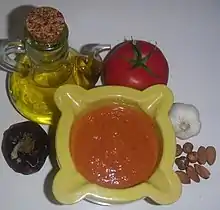
Sauces in Catalan cuisine include:
- Salvitxada – Sauce from Catalan cuisine
- Xató – Sauce in Catlan cooking
- Romesco
- Alioli – Mediterranean sauce made of garlic and olive oil, optionally egg yolks and seasonings
Sweden
Sauces in Swedish cuisine include:
- Brunsås
- Hovmästarsås - made with mustard and dill
- Lingonberry sauce
- Skagen sauce - made with shrimp, mayonnaise and other ingredients
Switzerland
Sauces in Swiss cuisine include:
- Café de Paris sauce – Butter-based sauce[50] – a butter-based sauce served with grilled beef
Thailand
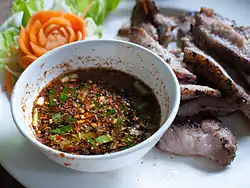
Sauces in Thai cuisine include:
- Nam chim
- Nam phrik – Thai chili sauce
- Sriracha sauce[51]
- Sweet chili sauce – Condiment primarily used as a dip
- Nam chim seafood
- Prik nam pra
- Nam chim gai
United Kingdom

Sauces in British cuisine include:
- Albert sauce
- Apple sauce – Sauce or puree made from apples
- Bread sauce
- Brown sauce – Condiment served with food in the UK and Ireland
- Cheddar sauce
- Cumberland sauce – Fruit sauce (Oxford sauce)
- Gravy – Sauce made from the juices of meats
- Horseradish sauce
- Marie Rose sauce – British condiment
- Mint sauce – Sauce made of chopped mint
- Mushroom sauce
- Onion gravy
- Parsley sauce
- Redcurrant sauce
- Shrewsbury sauce – English savoury sauce
- Tewkesbury mustard
- Whisky sauce
- White sauce
- Worcestershire sauce – Fermented condiment
- Wow-Wow sauce, also known as Bow Wow Sauce – Sauce
United States

Sauces in the cuisine of the United States include:
- Alfredo sauce – Italian pasta dish with butter and cheese
- Barbecue sauce – Sauce used as a marinade, basting, topping or condiment
- Brown gravy – Sauce made from the juices of meats
- Buffalo sauce – American dish of spicy chicken wings
- Cincinnati chili – Spiced meat sauce used as a topping for spaghetti
- Coffee sauce
- Comeback sauce – Sauce for fried food from Mississippi
- Coney sauce – American fast food item[52]
- Cranberry sauce – Sauce or relish made from cranberries
- Duck sauce – American Chinese condiment with a translucent orange appearance
- Étouffée sauce – American seafood and rice dish
- Henry Bain sauce
- Huli-huli sauce – Hawaiian chicken dish
- Lobster sauce
- Mumbo sauce – American regional sauce
- Michigan sauce – Style of hot dog
- Old Sour
- Red-eye gravy
- Remoulade – Mayonnaise-based cold sauce
- Sausage gravy – Breakfast dish from the Southern United States
- Tomato sauce – Sauce made primarily from tomatoes
- Vodka sauce
Vietnam
Dipping sauces are a mainstay of many Vietnamese dishes. Some of the commonly used sauces are:[53]
- Mắm tôm - Fermented shrimp sauce
- Mắm Kho Quẹt - Caramalised, vegetable dip
- Mắm Nêm - Anchovy sauce
- Muối ớt xanh sữa đặc chấm hải sản - Green chili with seafood sauce
- Nước chấm – Vietnamese dipping sauce
- Nước mắm chấm - Salty fish sauce
- Nước mắm đường - Sweet fish sauce
- Nứơc mắm gừng - Ginger fish sauce
- Tương Chấm Gỏi Cuốn - Peanut sauce
Prepared sauces
- A.1. Sauce – Brand of brown sauce condiment
- Alfredo sauce
- Baconnaise – Brand of bacon-flavored condiment
- Cheez Whiz – Trademarked processed cheese
- Daddies
- HP sauce – British sauce made with tamarind
- Ketchup – Sauce used as a condiment
- Maggi – International food brand
- Magic Shell
- McDonald's sauces
- Mustard (condiment) – Condiment made from mustard seeds
- OK Sauce
- Pickapeppa Sauce
- Salsa Lizano
- Salsa (prepared)
- Tapatío hot sauce – American hot sauce
- Prego
See also
- Chutney – South Asian condiments made of spices, vegetables, and fruit
- Compound butter – Mixtures of butter and supplementary ingredients
- Condiment – Substance added to food to impart or enhance a flavor
- Deglazing (cooking)
- Dipping sauce – Type of sauce
- List of dips
- Fermented bean paste – Fermented foods made from ground soybeans
- Fondue – Swiss melted cheese dish
- Gastrique – Caramelized sugar, deglazed with vinegar
- List of condiments
- List of dessert sauces
- List of fish sauces
- List of hot sauces
- List of mayonnaises
- List of meat-based sauces
- List of syrups
- Marination – Process of soaking foods in a seasoned, often acidic, liquid before cooking
- Outline of food preparation – 1=Overview of and topical guide to food preparation
- Reduction (cooking)
- Relish – Cooked, pickled, or chopped vegetable or fruit used as a condiment
- Sauce boat – Boat-shaped pitcher in which sauce or gravy is served
- Saucery
- Saucier
- Soup – Primarily liquid food
- Spread (food)
- Sweet bean paste
References

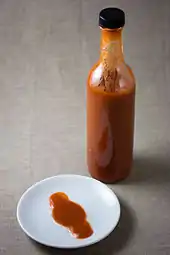
- Bruce Bjorkman (1996). The Great Barbecue Companion: Mops, Sops, Sauces, and Rubs. p. 112. ISBN 0-89594-806-0.
- Peterson, J. (2017). Sauces: Classical and Contemporary Sauce Making. Houghton Mifflin Harcourt. p. 148. ISBN 978-0-544-81982-5. Retrieved December 16, 2020.
- Peterson, J. (2017). Sauces: Classical and Contemporary Sauce Making, Fourth Edition. HMH Books. p. 154. ISBN 978-0-544-81983-2. Retrieved December 16, 2020.
- Whitehead, J. (1889). The Steward's Handbook and Guide to Party Catering. The Steward's Handbook and Guide to Party Catering. J. Anderson & Company, printers. p. 273. Retrieved June 15, 2017.
- Escoffier, Auguste (1969). The Escoffier Cookbook. Crown Publishers, Inc.
- Corriher, Shirley (1997). "Ch. 4: sauce sense". Cookwise, the Hows and Whys of Successful Cooking (1st ed.). New York: William Morrow & Company, Inc. ISBN 0-688-10229-8.
- Prosper Montagné (1961). Charlotte Snyder Turgeon; Nina Froud (eds.). Larousse gastronomique: the encyclopedia of food, wine & cookery. Crown Publishers. p. 861. ISBN 0-517-50333-6. Retrieved April 16, 2012.
- Beck, Bertholle and Child, pp. 94−95
- "Béchamel definition". Merriam-Webster.
- Victor Ego Ducrot (1998), Los sabores de la Patria, Grupo Editorial Norma. (in Spanish)
- Carrington, Sean; Fraser, Henry C. (2003). "Pepper sauce". A~Z of Barbados Heritage. Macmillan Caribbean. p. 150. ISBN 0-333-92068-6.
- D&L Archived August 19, 2014, at the Wayback Machine, La William
- Escoffier, Auguste (1903). Le guide culinaire, aide-mémoire de cuisine pratique. Par A. Escoffier. Emile Colin (imprimerie de Lagny). pp. 132–135.
- Escoffier, Auguste (1934). Ma cuisine. 2 500 recettes. p. 28. Escoffier, Auguste (1912). Le guide culinaire, aide-mémoire de cuisine pratique. Par A. Escoffier. p. 48. Escoffier, Auguste (1912). Le guide culinaire, aide-mémoire de cuisine pratique. Par A. Escoffier. pp. 33–34.
- Escoffier, Auguste (1907). A guide to Modern Cookery. p. 27.
- "The 5 French Mother Sauces Explained". Michelin Guide.
- Escoffier, A. (1979) [1921]. Le guide culinaire = The complete guide to the art of modern cookery : the first complete translation into English (1st American ed.). New York: Mayflower Books. p. 64. ISBN 0831754788. Retrieved 16 December 2020.
- Fuller and Renold, recipe no. 80
- Hering, p. 46
- Fuller and Renold, recipe no. 81
- Fuller and Renold, recipe no. 82
- Saulnier, p. 6
- Fuller and Renold, recipe no. 54
- Hering, p. 37
- Saulnier, p. 17
- Saulnier, p. 18
- Fuller and Renold, recipe no. 16
- Saulnier, p. 18
- Fuller and Renold, recipe no. 29
- Saulnier, p. 20
- Fuller and Renold, recipe no. 34
- Saulnier, p. 21
- Saulnier, p. 22
- Beck, Bertholle and Child, p. 184
- Saulnier, p. 23
- Saulnier, p. 23
- Hering, p. 54
- Saulnier, p. 24
- Beck, Bertholle and Child, p. 51
- Elizabeth David, Italian Food (1954, 1999), p 319, and John Dickie, Delizia! The Epic History of the Italians and Their Food, 2008, p. 162.
- Accademia Italiana della Cuisine, La Cucina - The Regional Cooking of Italy (English translation), 2009, Rizzoli, ISBN 978-0-8478-3147-0
- Jung, Soon Teck & Kang, Seong-Gook (2002). "The Past and Present of Traditional Fermented Foods in Korea". Archived from the original on December 23, 2007. Retrieved January 7, 2008.
- Gur, Jana; (et al.) (2007). The Book of New Israeli Food: A Culinary Journey. Schocken Books. pg. 295. ISBN 9780805212242
- Smith, Andrew F. (May 1, 2007). The Oxford companion to American food and drink. Oxford University Press. p. 29. ISBN 978-0-19-530796-2. Retrieved March 14, 2012.
- Hall, Phil (March 19, 2008). "Holy Mole". The Guardian. London. Retrieved August 20, 2010.
- John B. Roney (2009). Culture and Customs of the Netherlands. ABC-CLIO, LLC. p. 133. ISBN 978-0-313-34808-2. Retrieved May 21, 2012.
- Eve Zibart (2001). The Ethnic Food Lover's Companion: A Sourcebook for Understanding the Cuisines of the World. Menasha Ridge Press. p. 270. ISBN 978-0-89732-372-7.
- "À la Polonaise". CooksInfo. Retrieved February 28, 2021.
- "Definition of mujdei" (in Romanian). DEX online.
- "John Lichfield: Our Man In Paris: Revealed at last: how to make the French queue". The Independent. July 2, 2007. Retrieved September 5, 2012.
- Edge, John (May 19, 2009). "A Chili Sauce to Crow About". New York Times. Retrieved May 20, 2009.
- Cameron, J.N. (2015). Seven Neighborhoods in Detroit: Recipes from the City. Beneva Publishing. p. 148. ISBN 9780996626101.
- "10 Popular Vietnamese Dipping Sauces". Vietnamese Home Cooking Recipes. Retrieved 2020-12-21.
Book sources
- Beck, Simone; Louisette Bertholle; Julia Child (2012) [1961]. Mastering the Art of French Cooking, Volume One. London: Particular. ISBN 978-0-241-95339-6.
- Fuller, John; Edward Renold (1992). The Chef's Compendium of Professional Recipes. Oxford: Butterworth-Heinemann. ISBN 978-0-7506-0490-1.
- Hering, Richard (1989). Hering's Dictionary of Classical and Modern Cookery (eleventh ed.). London: Virtue. ISBN 978-3-8057-0307-9.
- Saulnier, Louis (1978). Le Répertoire de la Cuisine (fourteenth ed.). London: Jaeggi. OCLC 1086737491.
Further reading
- Sokolov, Raymond (1976). The Saucier's Apprentice. Knopf. ISBN 0-394-48920-9.
- Corriher, Shirley (1997). "Ch. 4: sauce sense". Cookwise, the Hows and Whys of Successful Cooking (1st ed.). New York: William Morrow & Company, Inc. ISBN 0-688-10229-8.
- Murdoch (2004) Essential Seafood Cookbook Seafood sauces, p. 128–143. Murdoch Books. ISBN 9781740454124
- Brandau, Mark (August 30, 2012). "Restaurant chains experiment with sauces to add flavor". Nation's Restaurant News magazine. Retrieved September 5, 2012.
- "Emerging Sauces". Foodservice Research Institute. 2011. Archived from the original on March 4, 2016. Retrieved September 5, 2012.
External links
| Wikiquote has quotations related to: List of sauces |
| Wikimedia Commons has media related to Sauces. |
| Wikibooks Cookbook has a recipe/module on |
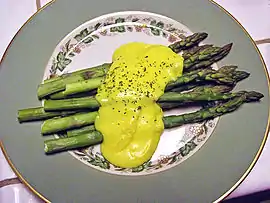
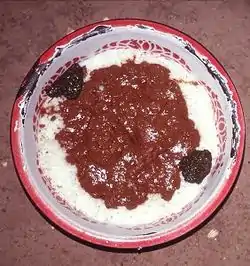
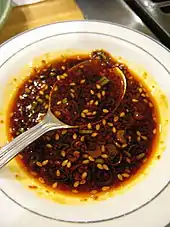
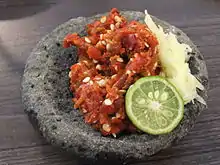

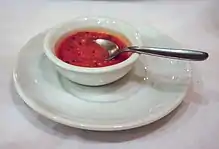
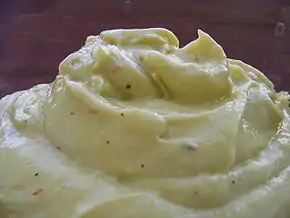
.jpg.webp)
